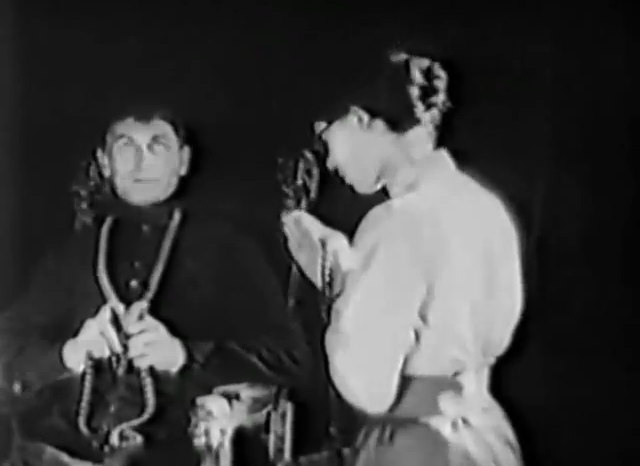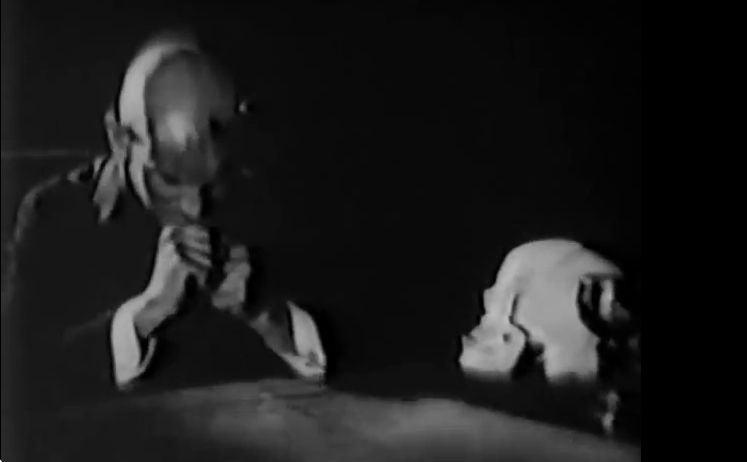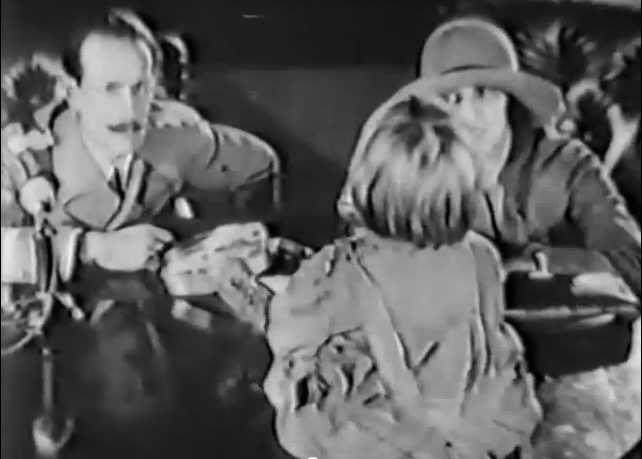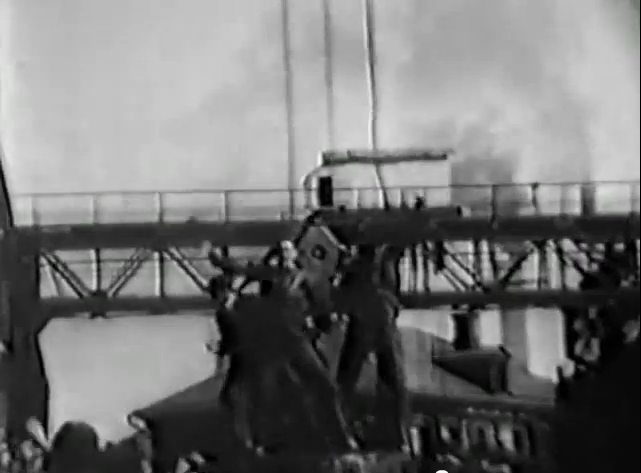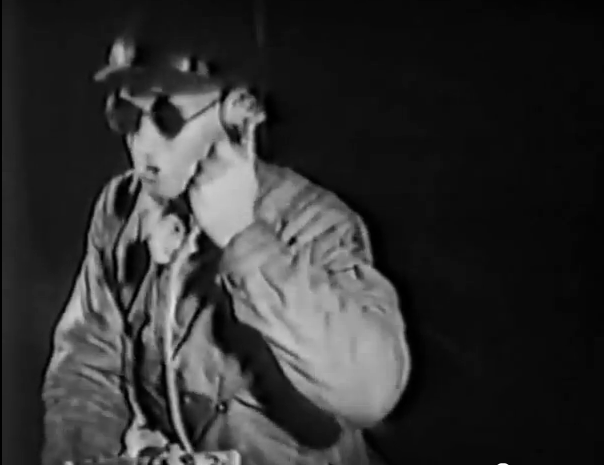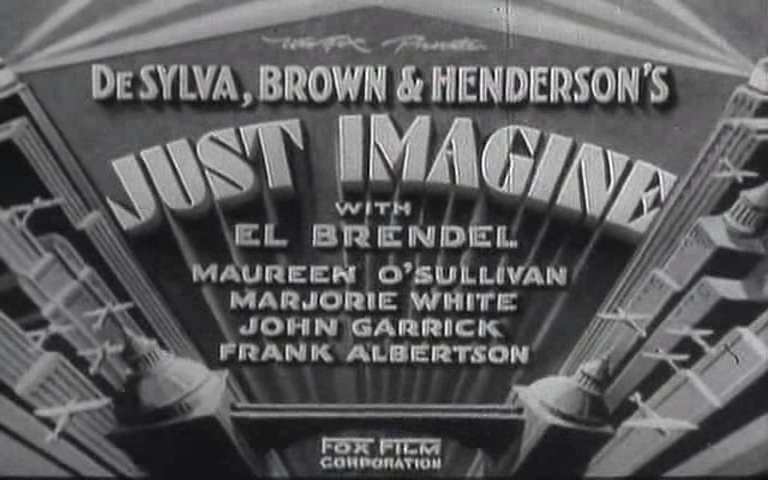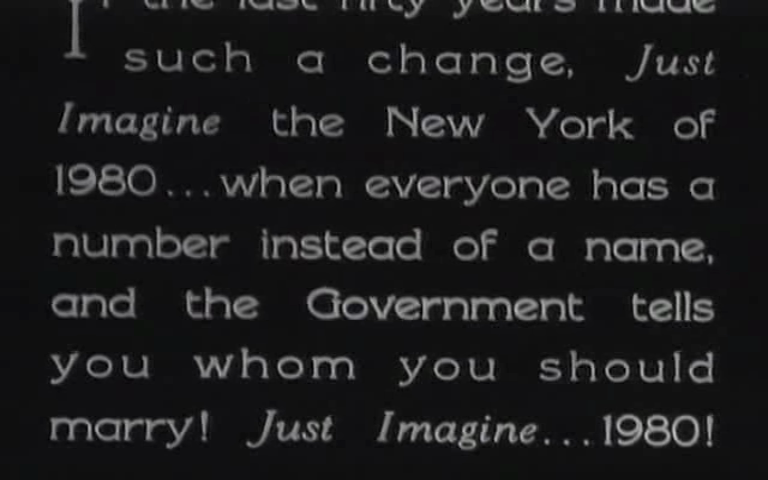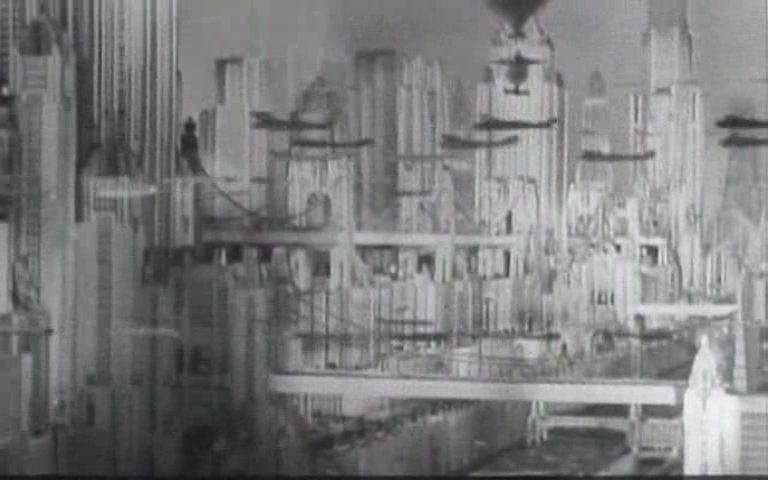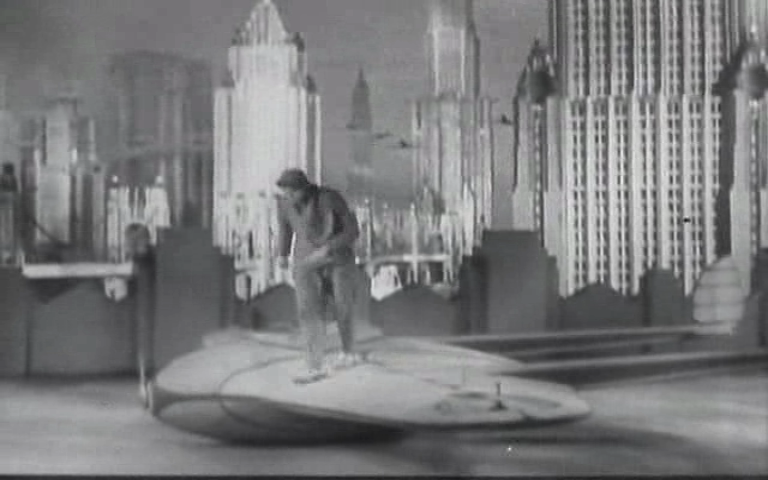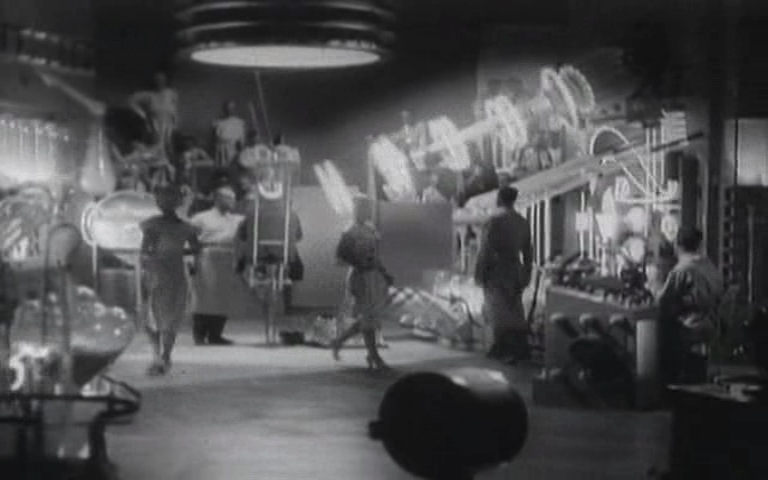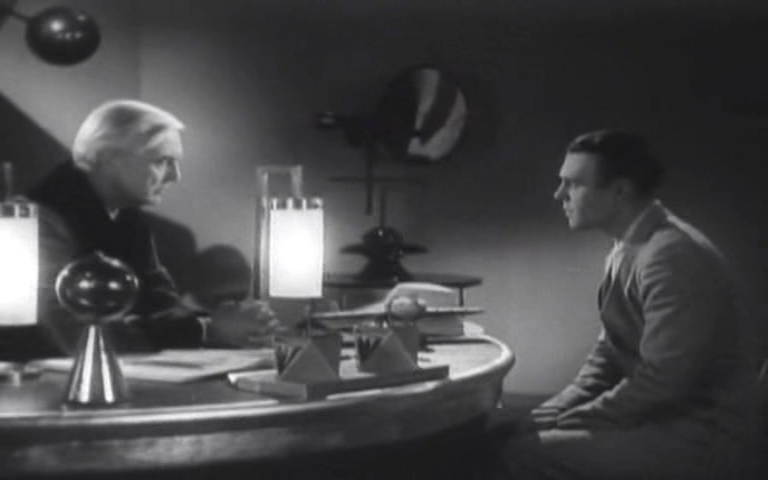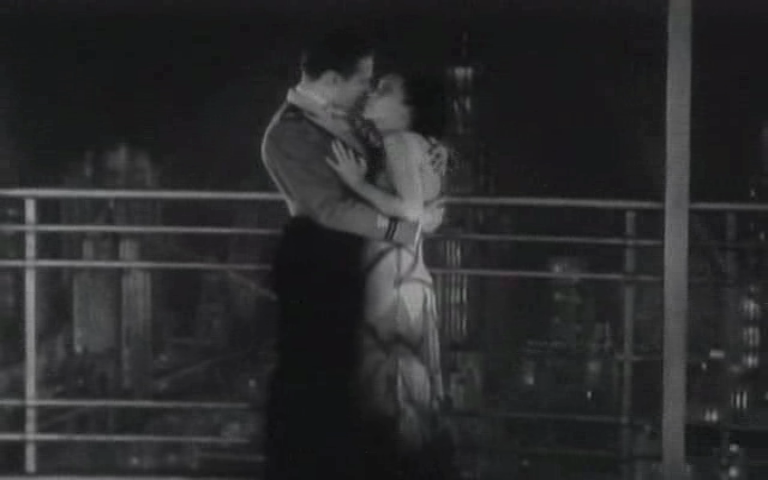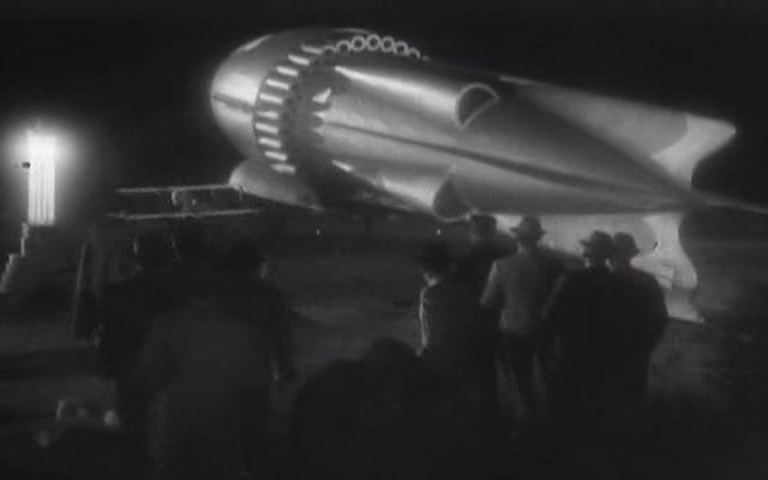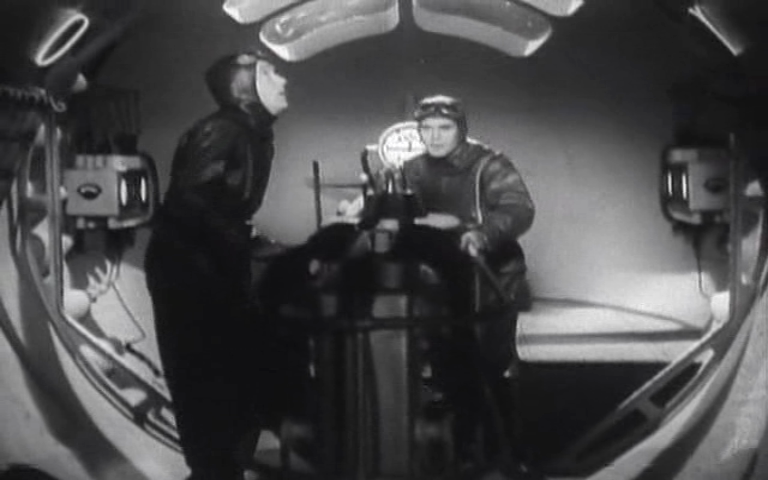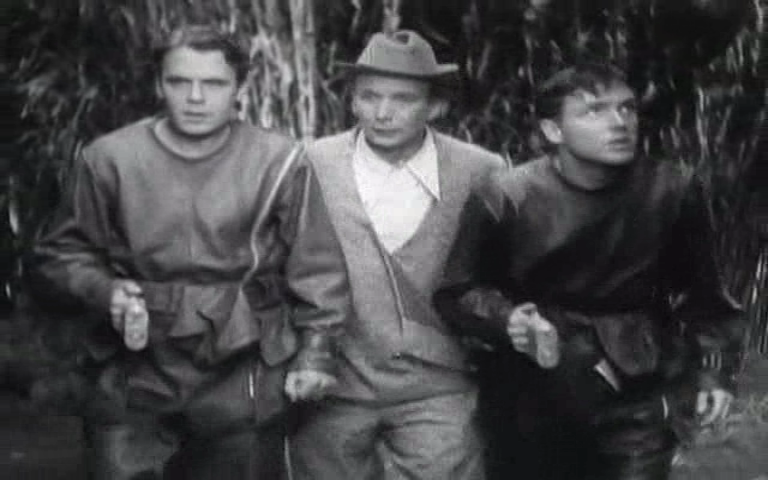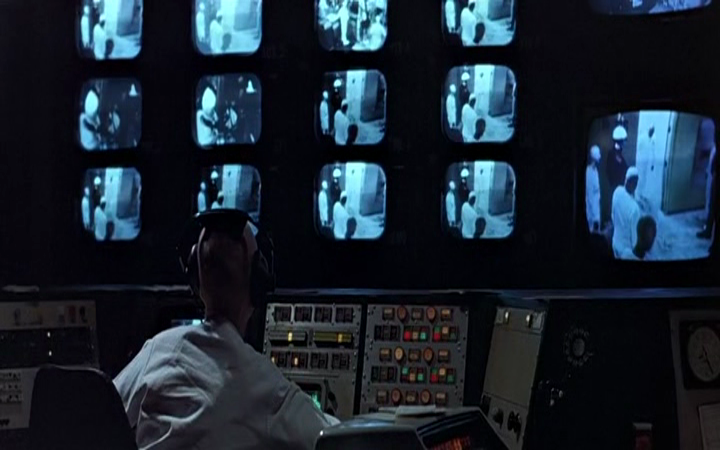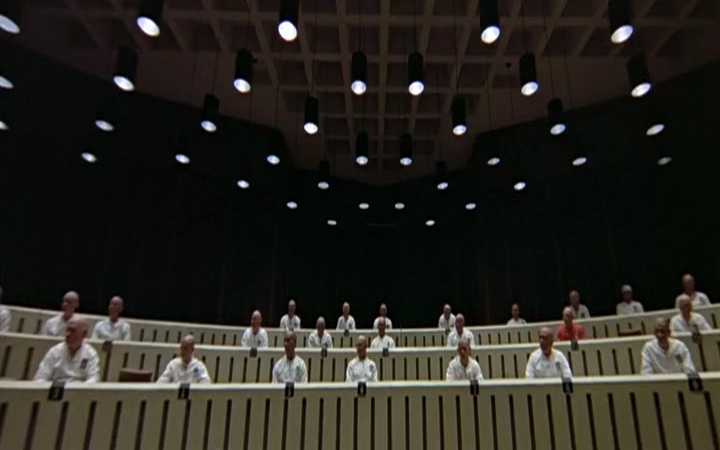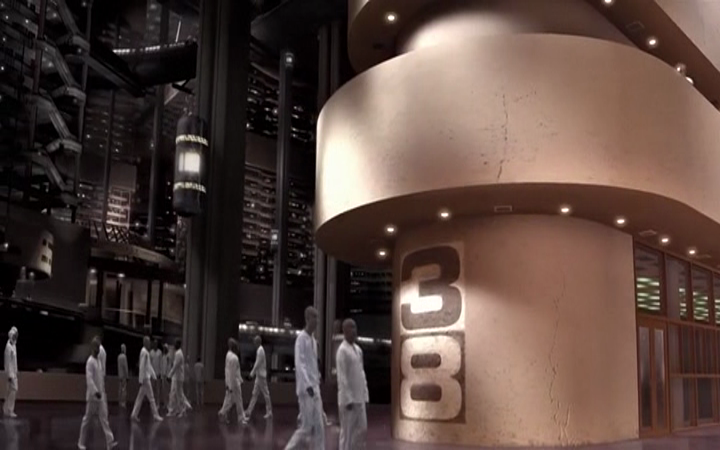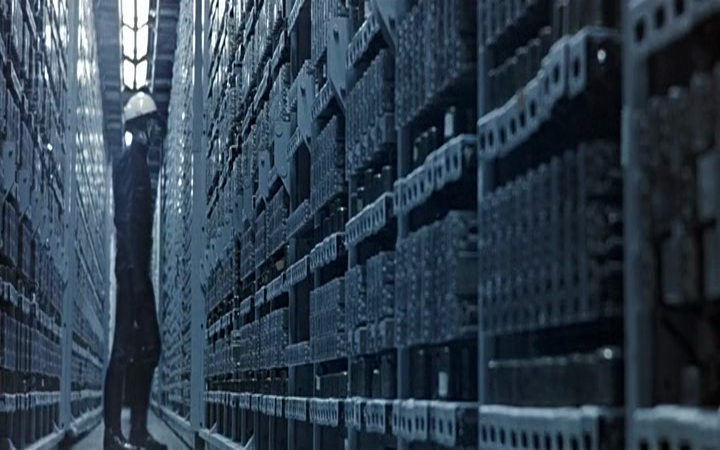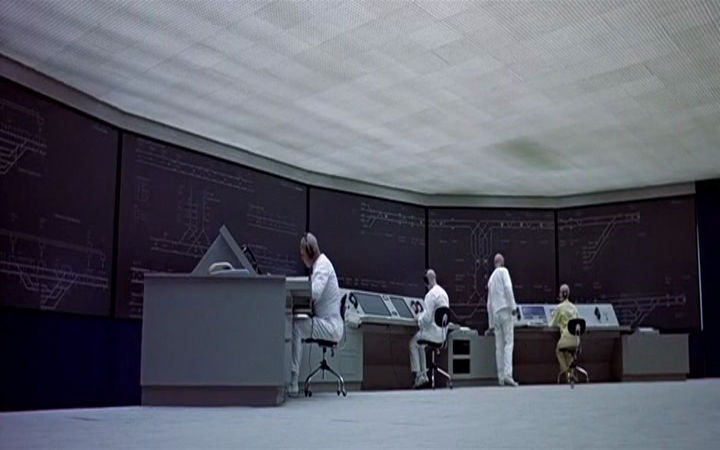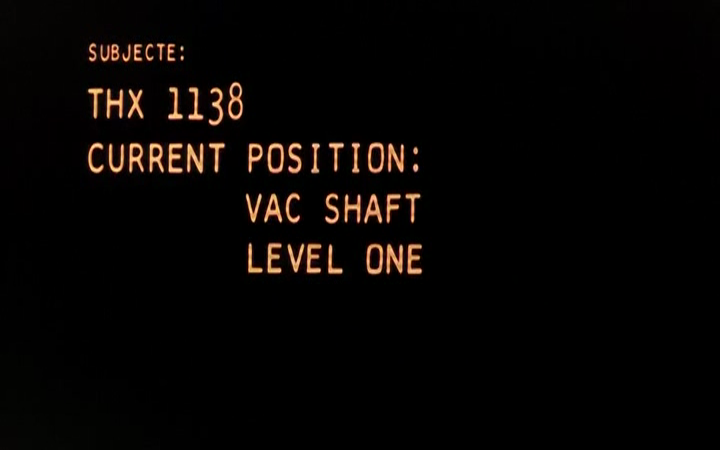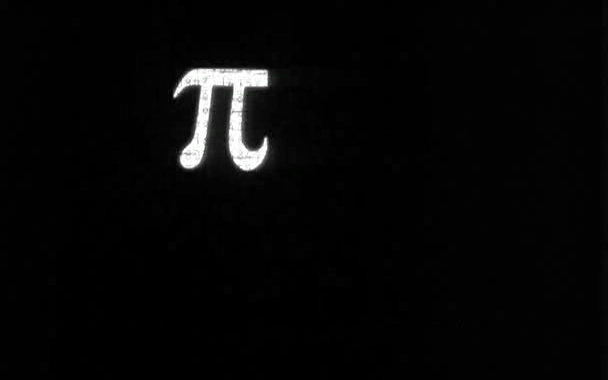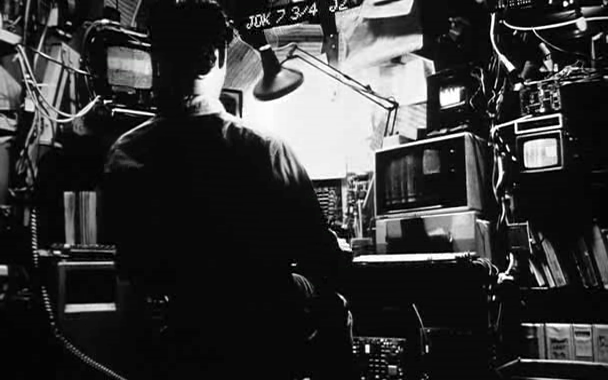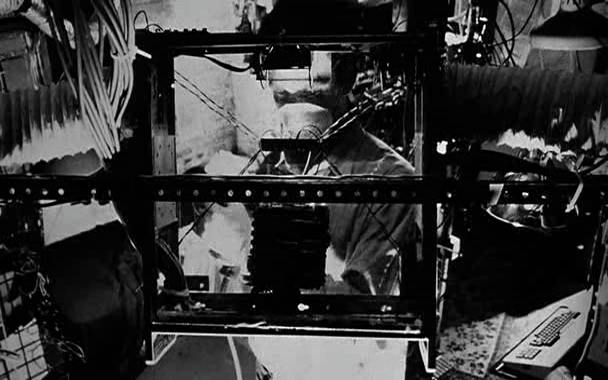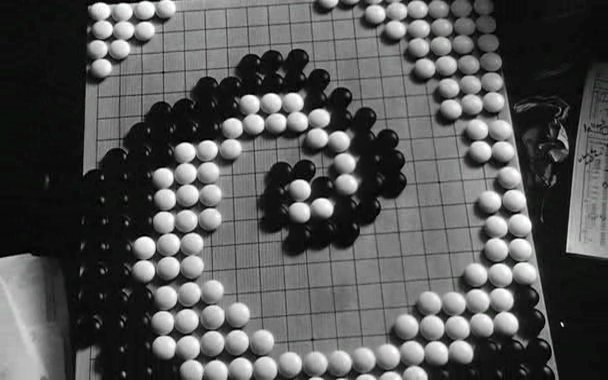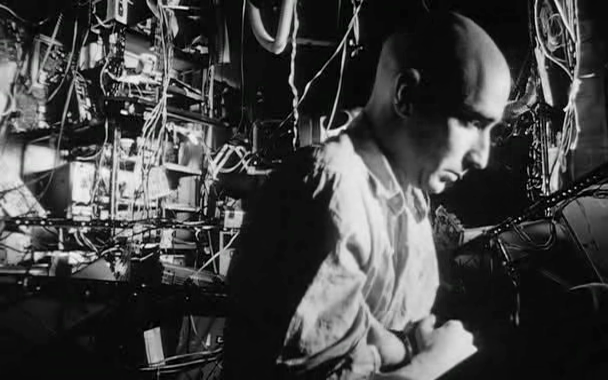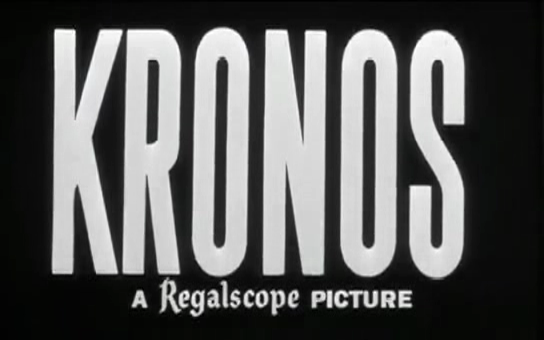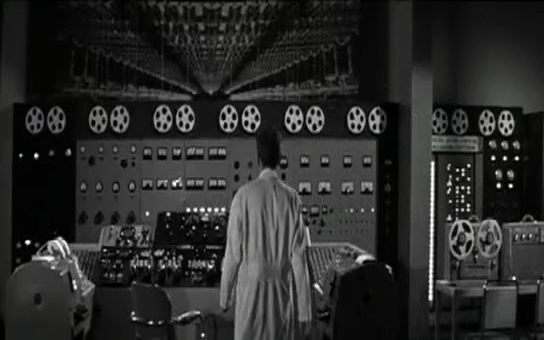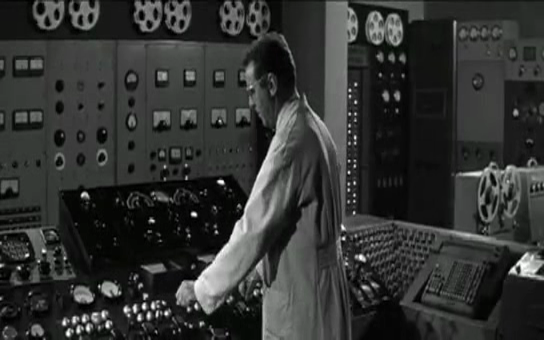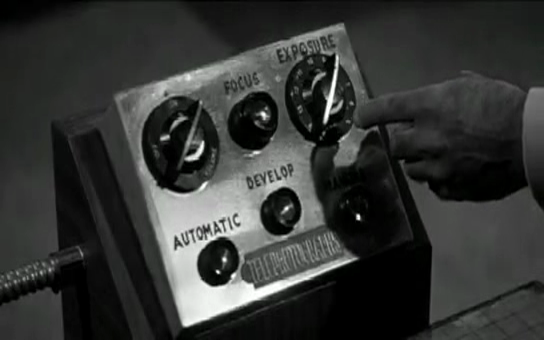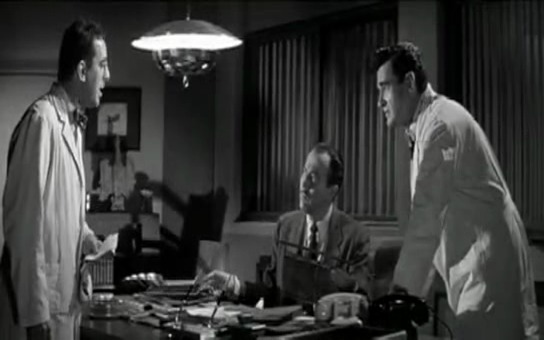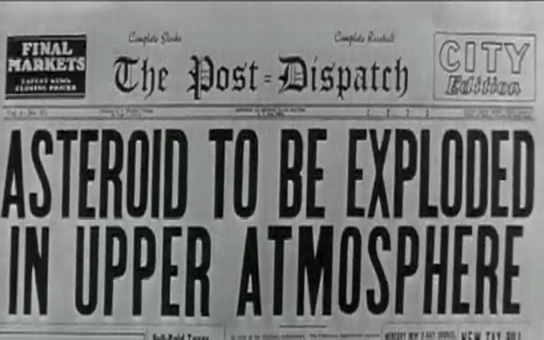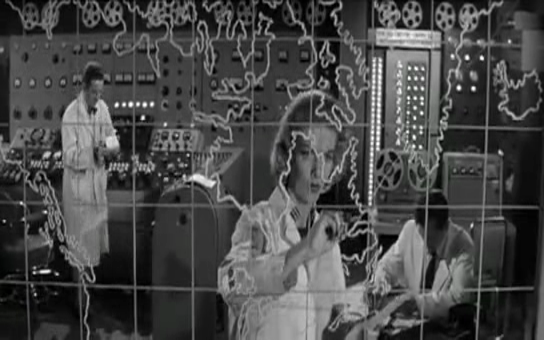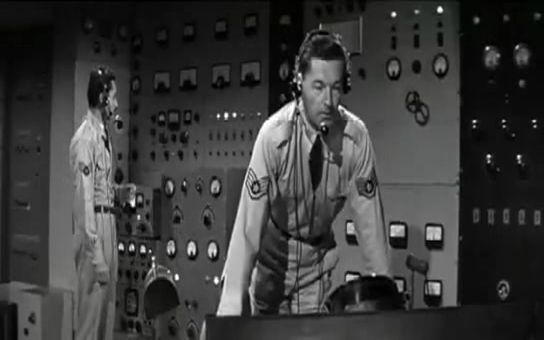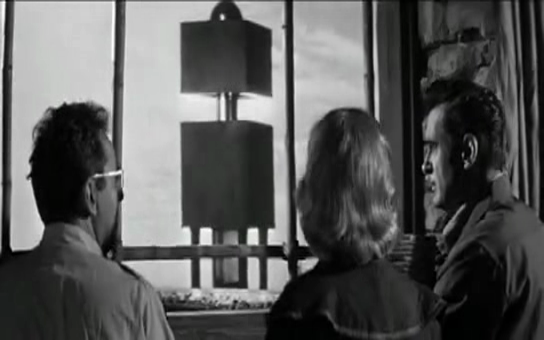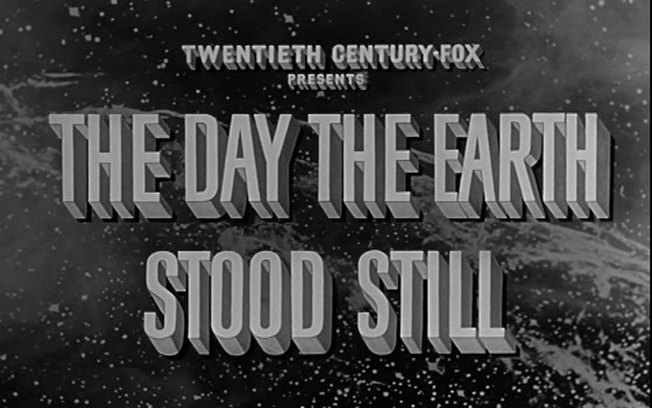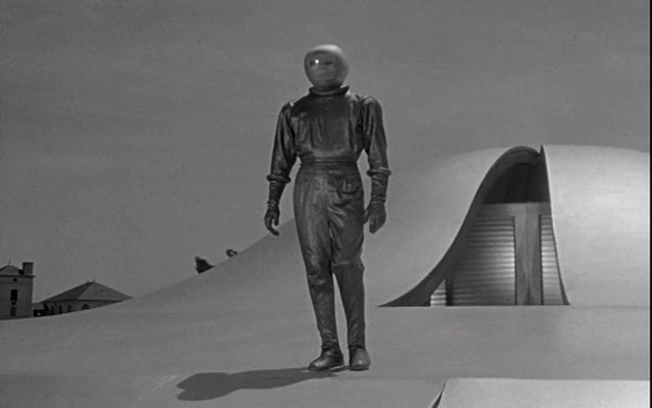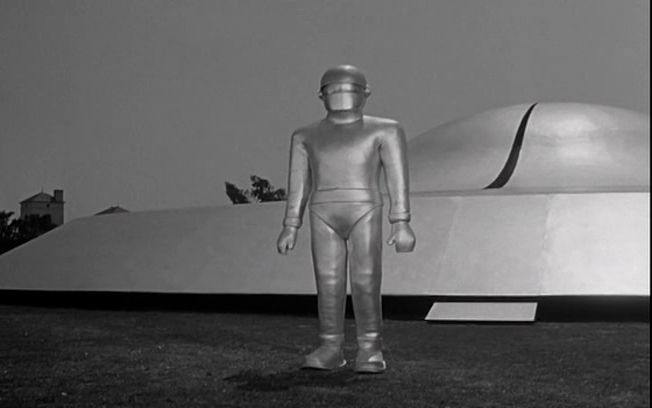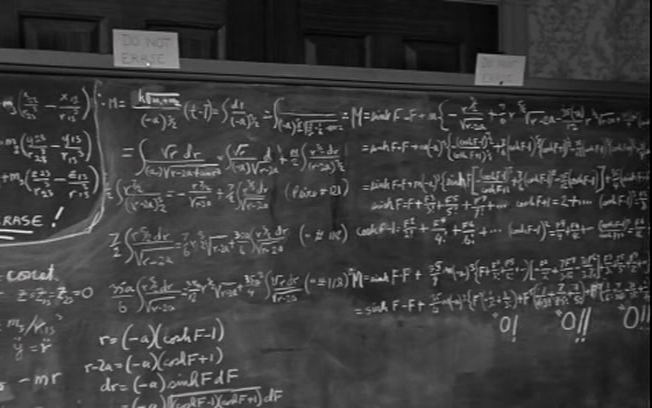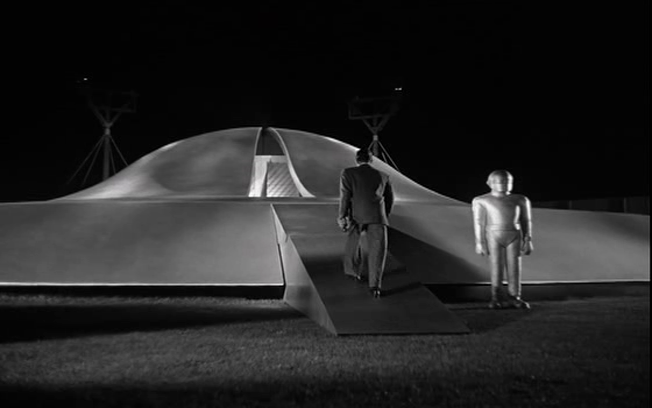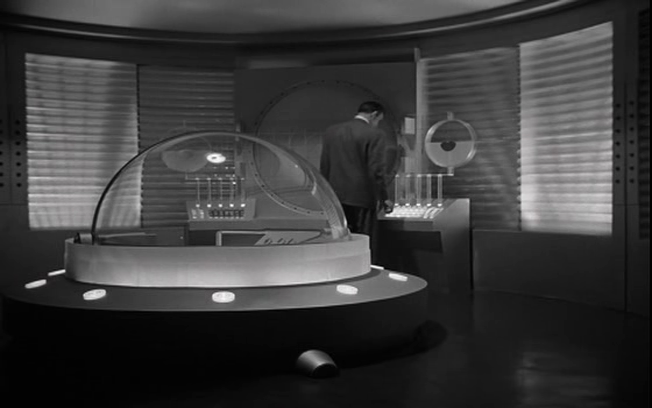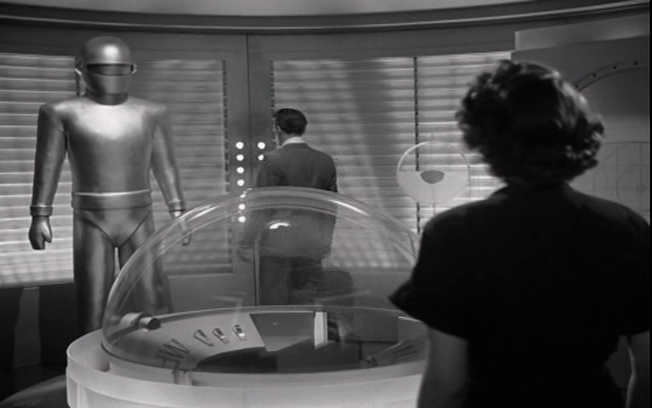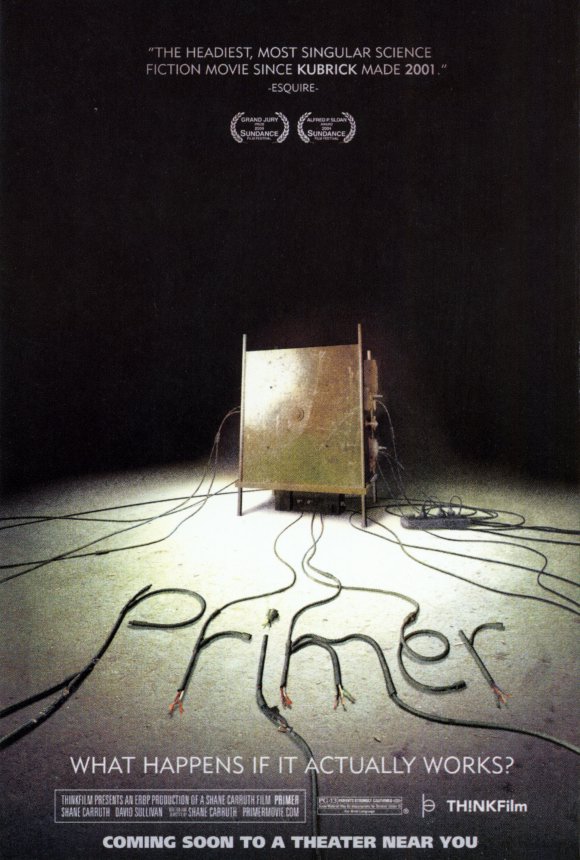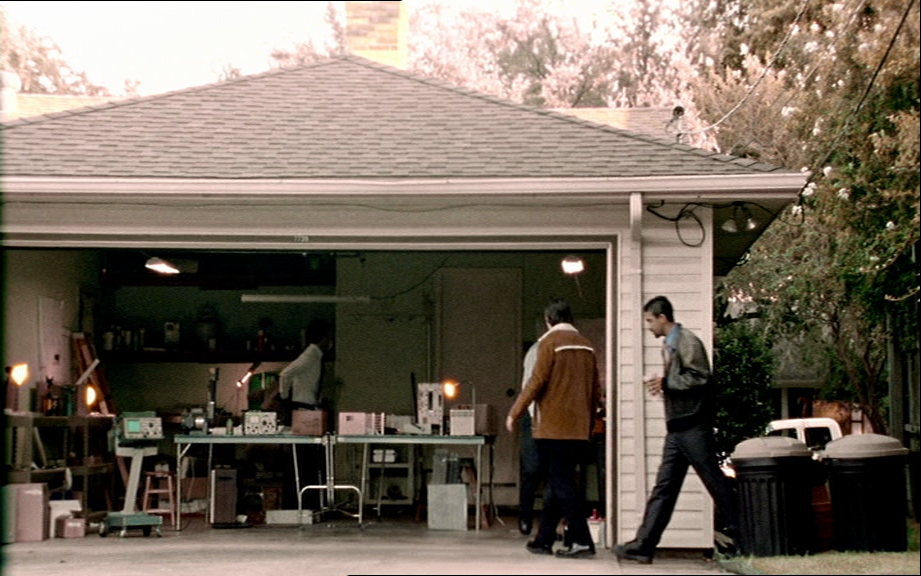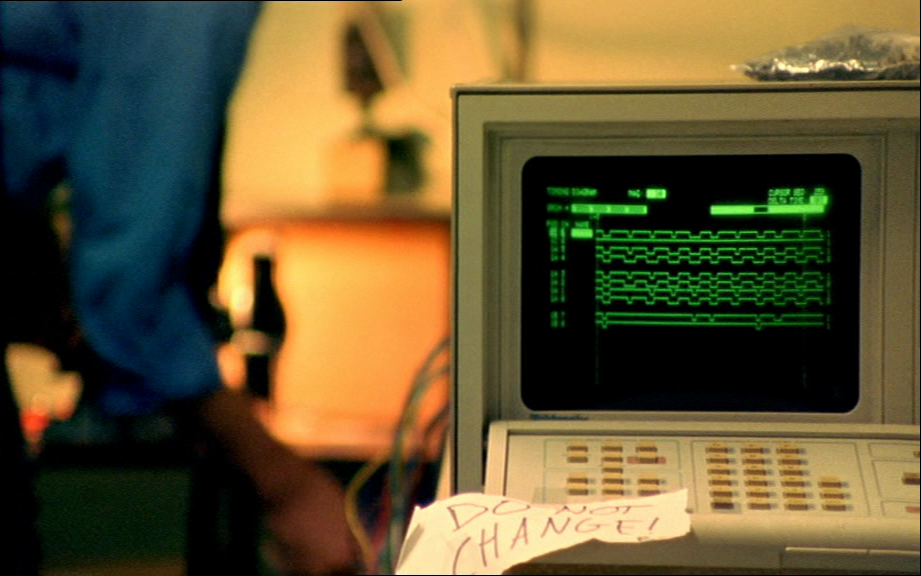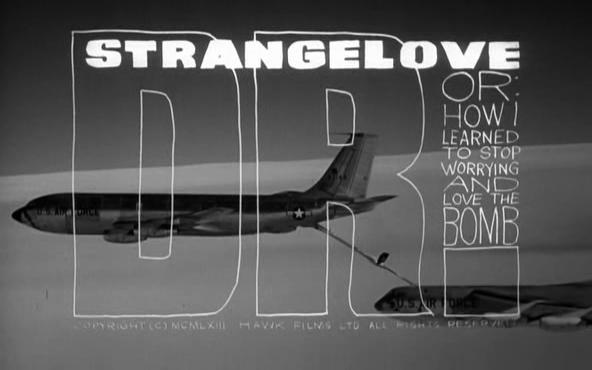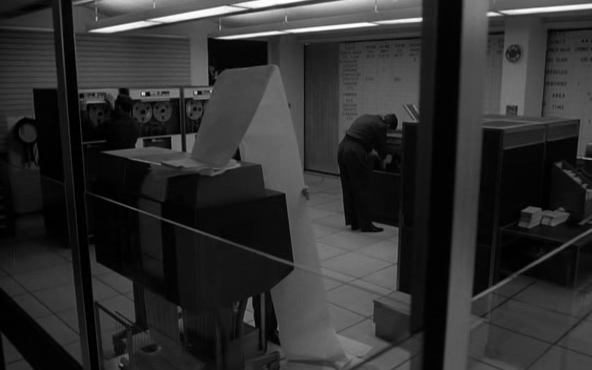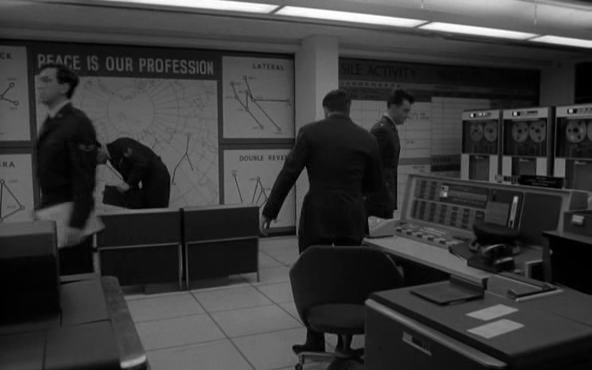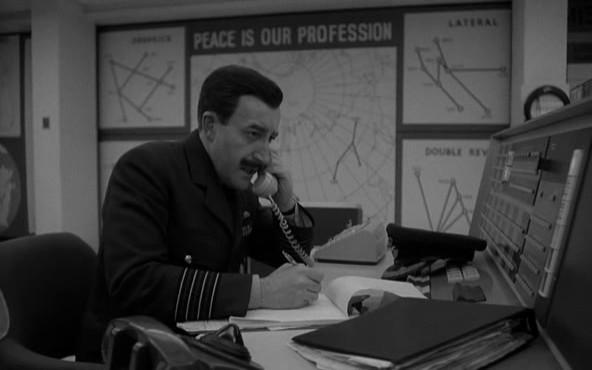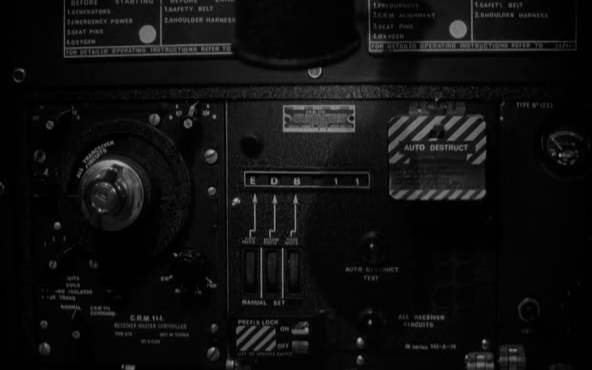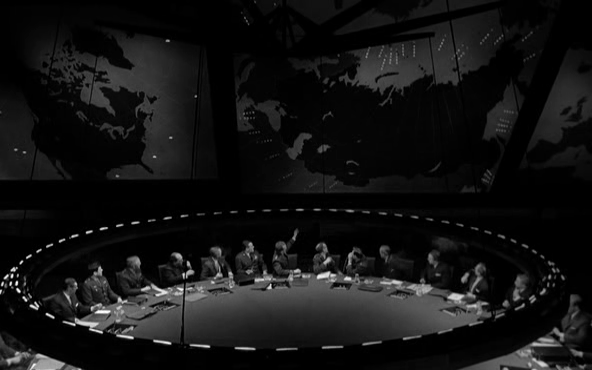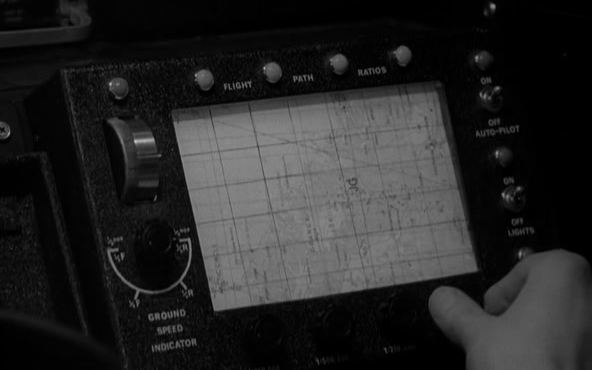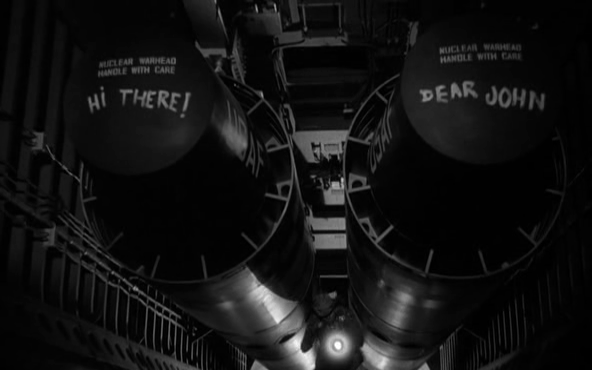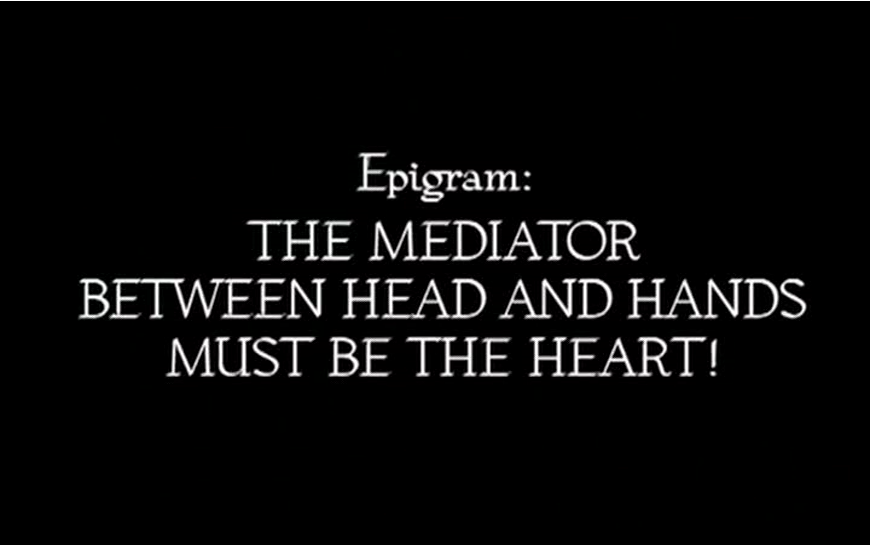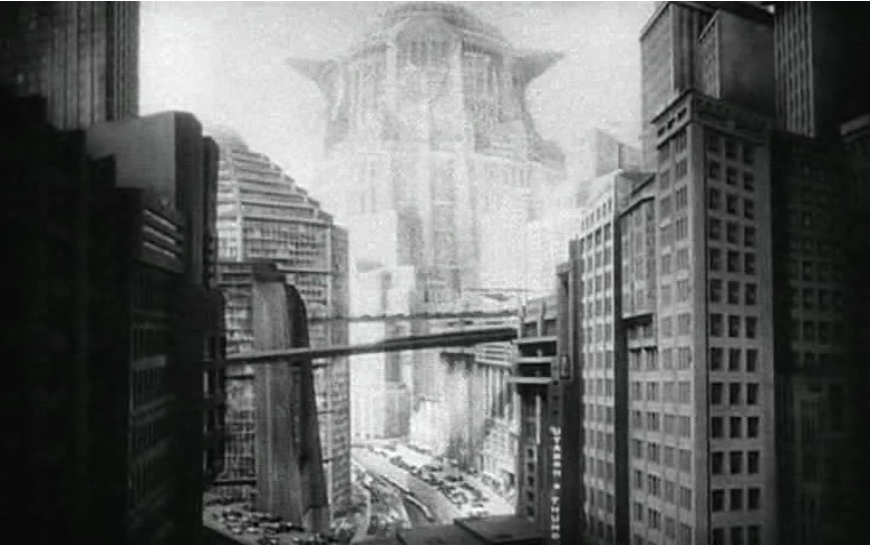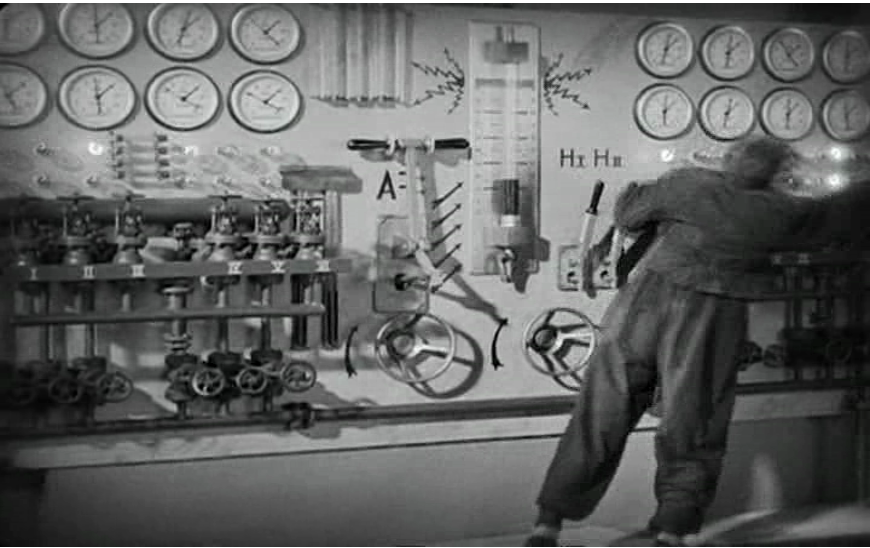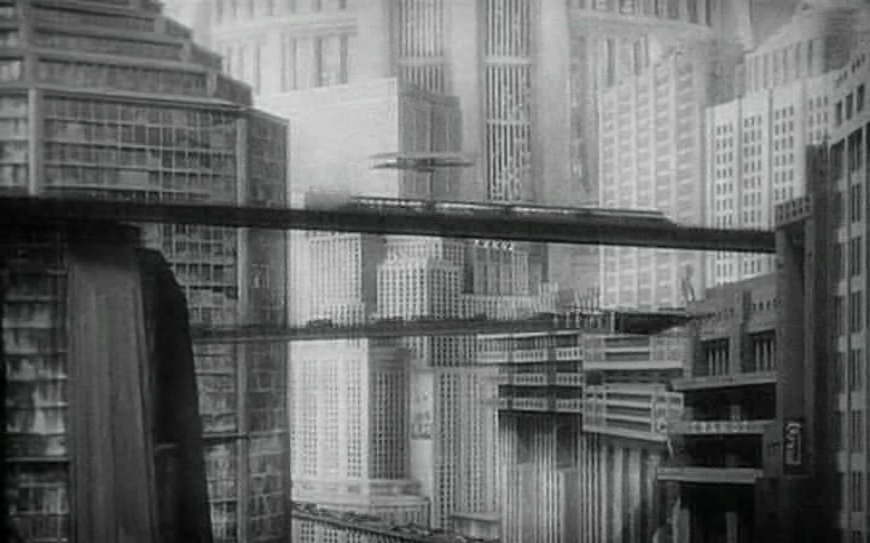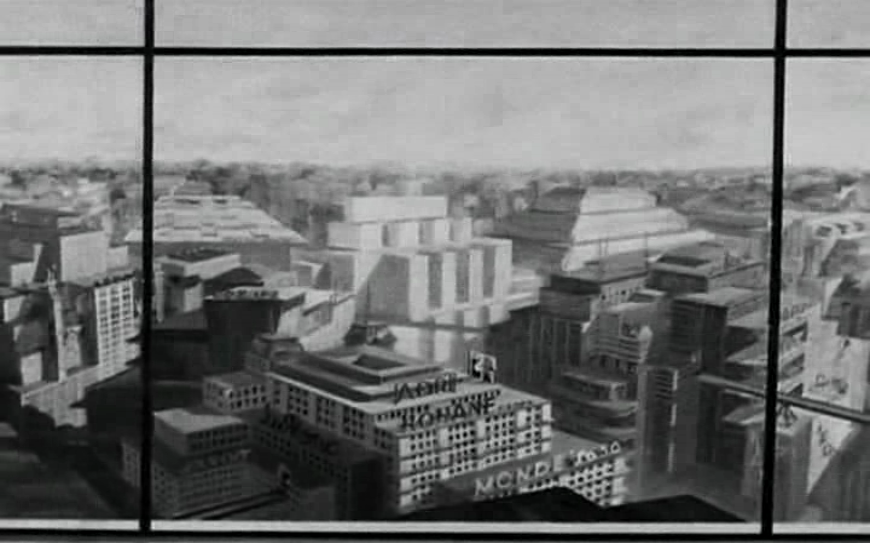-
#14 – The Death Ray (1925)
The Death Ray (1925)
Film review #14
Director: Lev Kuleshov
A Soviet sci-fi spy thriller from the 20’s packed with action…
In an unnamed “fascist” country, Tomas Lann is imprisoned at a “helium factory”, but manages to escape during a revolt. He flees to the home of Professor Podobed, where he wishes to get the “death ray” he has been working on to fight the fascists. However, one of the fascists, Father Revo, breaks into the Professor’s home and steals the death ray. Lann then chases down another one of the fascists named Fog in order to get the death ray back.
First, I should note that there is no English translation for this film, so my understanding of the movie is a bit limited, and as you can see from the stills above, the only surviving copy of the film is a bit poor in quality. Nevertheless, ever since I heard about this movie, I’ve wanted to watch it. Apparently, there are portions of the movie missing as well, which makes it even harder to understand the narrative.
This movie offers a different take on filmmaking in the 1920s. Before even Metropolis was released, The Death Ray (Luch Smerti in Russian) was released in the USSR, a film by “popular” Soviet filmmaker Lev Kuleshov. Film making in the USSR at this time was tightly regulated by the government, and apparently this film was criticized greatly by them because of a lack of soviet propaganda, and it was too “American” in terms of its production, with a lot of focus on stunts and action.
On that subject, the sheer amount of action in this movie is insane. The actors are jumping from 3-story buildings, hanging from wires suspended on rooftops, crashing through tables and doors, jumping from moving cars, falling down stairs and even running towards oncoming trains and lying down on tracks in front of them, with the train changing tracks at the last second. Now, I’m pretty sure there were no stunt doubles in this movie (or at all back then), so these actors must have been made of strong stuff, and had no sense of fear when filming these sequences. The action takes place in car chases, bike chases, and even a plane sequence, all culminating in a gun/knife fight at the end. Perhaps one of the reasons it is hard to follow the plot is because there is a lot more emphasis on action.
Throughout the film, the so-called “facist nation” is labelled as the antagonist of the film, and although no actual name is given to it, the use of swastikas throughout the movie by them strongly indicates that it is probably Germany or a mid-Europe country. This of course, would serve the USSR regime of painting the Europeans as an enemy of the soviet union rather nicely. Obviously the nazi movement was still in its early stages in 1925, but clearly it was still something the USSR wasn’t very keen on. Looking back on it in the present, we can see this film in the wider context of soviet life, and how they perceived other countries. Another interesting aspect to this is the leader of the fascist nation: Father Revo, is seen as a religious leader. This again puts it in line with the soviet objective of eliminating religion, and portraying the antagonists as religious in this movie tows the USSR’s policy very well.
The film ends with Lann retrieving the death ray and using it on the enemy fighter planes, and finally liberating the prisoners of the factory where he first escaped. Though we never get a close look at the death ray (It is always locked up in a box), the idea of such a weapon being used to bring down the enemies of the USSR was a nice way to end a movie like this which was used as propaganda by the government.
Apparently this movie was also screened in America, though it is difficult to find where and when. I wonder what Americans thought of such a movie, riddled with the Hollywood action sequences and developed on the other side of the world? Either way, the death ray is a rare example of soviet cinema that may lack in plot, but more than makes up for it in terms of action.
-
#13 – Just Imagine! (1930)
Just imagine! (1930)
Film review #13
Director: David Butler
A science-fiction romantic comedy musical…Wait what?
In the year 1980 (fifty years in the future when this film was made), the world is a different place: People ride in planes around the cities, and can travel around the world in minutes. People also have government issued numbers instead of names, and the government decides who you can marry based on your success, which the basis for this movie.
J-21 is a pilot who wishes to marry LN-18, but MT-3 has also filed a request to marry her. A court rules that by law MT-3 gets to marry her, since he is the most successful man (Though it’s said he just published a paper his Father wrote before he died). LN-18 is unhappy with this arrangement, since she loves J-21 and she only accepted MT-3’s request for marriage on the behest of her Father. He is told he has an appeal in four months in which he will have a chance to win LN-18’s hand in marriage.
J-21’s roommate RT-42 is going with his girl D-6 to see an experiment where scientists are attempting to revive a man struck by lightning in 1930. J-21 tags along to the experiment, which is a success. The man, now revived, has nowhere to go, so J-21 invites him to stay with them. He picks himself a number: O-0, and so he is referred to as “Single O” from now on.
Single O is introduced to a world where babies are bought, and food and drink comes in pills. J-21 sneaks into LN-18′s apartment, but Single O’s drunken antics get him caught by MT-3 and he is thrown out. While walking round the city streets alone in sorrow, he is greeted by a man that offers him an opportunity. He takes J-21 to see the great inventor Z-4, who says he needs a pilot for his “space plane” to be the first person to go to Mars. J-21 is reluctant, but after Z-4 reminds him that this accomplishment would allow him to win his appeal in marriage to LN-18, he agrees to do it.
J-21 and RT-42 set off for Mars, and when they have launched, they find Single O has stowed away because he has nowhere else to go. The three of them arrive on Mars, and set about exploring. They stumble upon a Human-like tribe who communicate primarily through gesture. When the three heroes are captured by another tribe, they realise that everyone on Mars in born with a twin: One is good, and one is bad. They launch a daring escape and hurry to their ship before they miss their launch window. Back on Earth, J-21s appeal is starting, and he has not returned. D-6 tries to stall for time, while the three heroes arrive. He says he has been to Mars, and the judge requires proof, which Single O provides in the form of a captured evil twin from Mars. The judge rues in J-21s favour, and he and LN-18 are reunited and allowed to marry. Also, Single O is happily reunited with his son Axel, now an old man.
Now, when this film was released in 1930, the great depression was in full effect, and this film was intended as a pick-me-up for the public, hence the comedy musical elements. It provides an interesting perspective on the “future” of 1980, in which the speed of life develops even further, and becomes more automatised and regimented. Despite the clear control of the government in people’s lives, there is still an overall sense of optimism in the futuristic New York City. As I mentioned earlier, this is probably due to the film being a pick-me-up during the Great Depression, and I suppose this movie wanted to show that life would get better. The movie of course didn’t quite predict 1980 correctly, we don’t all have planes and roads in the sky, or buy babies from the government. But it is an imaginative view of 1980 regardless.
The production and effects in Just imagine are quite impressive for their time. It was one of the first films to use large-scale rear-screen-projection. All the skyline shots of New York City are done this way, and it very well done. The beginning sequence in the sky as well is put together nicely. Bits of technology such as the view-screen phones are imaginatively presented. It’s all the little bits of technology that really hold the believability of the film intact. With all of this, the film was very expensive in its time to make, and achieved reasonable success at the box office. It’s a shame it isn’t well known because it seems to be a very landmark film in terms of its production (Maybe the fact it has never had a VHS or DVD release is part of that problem?). In the 1930s, where there was perhaps little appetite for science-fiction, integrating it with the comedy and musical genres was a smart idea to garner wider appeal.
Of course, when the film came out, humanity was nowhere near getting to Mars or even launching anyone into space, so I imagine there was very little to go on when they were designing the Mars set. Looking at it in retrospect, we can safely say that the Mars in Just imagine with it’s vast jungles and human population is nothing like the actual planet Mars with it’s barren red landscape and no trace of life to be found.
As is par with the science-fiction genre, addressing social issues such as feminism crops up throughout the film. While it seems that men still hold the most powerful positions (The judge, inventor and the various extras are all men), there are women, such as the census taker at the start of the film, that have full careers, which would probably have been quite controversial for its time.
So overall I found Just imagine to be a really fun watch, it gives us an interesting look at the issues surrounding the 1930s, and just what society at that time was like and what they saw in the future. The blending of so many genres might seem strange, but it has a lot of charm, and incorporates them all very well. It is a shame this film isn’t well known or recognised, because in terms of its ambition and production, it seems to be an important example of western film development, and I would highly recommend a watch.
-
#12 – THX-1138 (1971)
THX-1138 (1971)
Film review #12
Director: George Lucas
From the creator of Star Wars comes a science-fiction film exploring the darker side of the imagined utopia…
THX 1138 envisions a future where everything is automatised. It is a departure from the traditional utopian visions of American culture, such as Buck Rogers in the 25th Century, of which a clip is shown at the start of the movie. This is a very clever way of questioning our pre-conceived notions of the future.
The story centres around a man named THX 1138, who is a resident of a futuristic society, where the populace is forced to take drugs to suppress their emotions in favour of efficiency, productivity and order. THX unknowingly stops taking his drugs thanks to his roomate LUH, who he starts to have feelings and impulses for. He also meets SEN, who is able to hack into the mainframe of the city to get things he wants. After THX nearly causes a meltdown after not taking his drugs and therefore being unable to perform at his job, he is put on trial and sentenced to confinement. After which he tries to escape the city and find LUH.
I think the most important aspect of THX 1138 is how de-humanised everything is: Sterile white walls cover everything, the only colour being in the pills the citizens take. There are no personal effects, the living quarters are as empty as everywhere else, and everyone has a shaved head, so identity is suppressed at every level possible. This shows in the dialogue in the movie too, which is staggered, fragmented, and just plain unnatural. Even the police force which enforces the law is made entirely of robots: People building there own regulators and taking the notions of justice out of their own hands seems to show a system where technology has taken control. The film could perhaps be seen as a commentary on communism and the power of the state too?
Even the notion of religion is seen as controlled by the all powerful computer. OHM 1190 is the state-sanctioned religious icon, and booths are available around the city for the residents to talk to and confide in, to which OHM will occasionally spout computer generated phrases such as “Yes, I understand” or “Excellent”. These booths are adorned with an image of Jesus as depicted in Hans Meming’s painting Christ Giving His Blessing (1478), which further that notion of a religious icon. Though one has to wonder what use a religious icon is in a city where every aspect of humanity is suppressed? Perhaps its random computer generated responses are appropriate for a population without humanity, and it is another way for the state to spy on people…Being made in 1971, the movie still stand the test of time well, possibly because there is not much in the movie which can age. Everything is neutral and bland by design, and so is resistant to ageing in the eyes of the movie-goer. Another reason for its lack of ageing may be the fact that I watched the directors cut, which has updated CGI and some re-filmed sequences, of which the director George Lucas is notorious for editing and touching up his old films (See the uproar over the constant remastering of Star Wars).
So overall, we have a very disturbing vision of society in the future in THX 1138, its strange, inhuman concepts address just what it means to be human amidst our technology, and whether that technology could ever control us? It seems to me that as a departure from the views of the future in American culture at that time, THX 1138 serves as a powerful alternate perspective on the future and still maintains that relevancy today.
-
#11 – Pi (1997)
Pi (1998)
Film review #11
dir. Darren Aronofsky
A psychological thriller about mathematics. What’s so psychological about mathematics you may ask?
Max Cohen is a mathematician who works with number theory. Ever since he started into the sun when he was six, he has had powerful headaches and pains, but he also gained a remarkable ability for calculating arithmetic sums. One day, when he is trying to find a formula for the stock markets, his computer spits out a 216-digit number and crashes. Thinking of it as an error, he carries on until he realises that the number he disregarded was correct, and that he had predicted the stock market crash.
This wraps Max up in a conspiracy between a number of vested interests such as a Wall Street company and a Jewish group. They believe the number can help them control the stock market, or bring about the messianic age, as the number would actually translate into the true name of God which was lost 2000 years ago.
The notion of everything in nature being able to be expressed in numbers is something we can accept to a point. Perhaps predicting the rise and fall of the stock market may be a little too far, but the film as a whole shows the power of numbers and what they can mean. Various bits of number theory and history are weaved throughout the film, so even if you’re not all that clued up on the history of mathematics, you can learn just about enough to get through the movie.
Pi isn’t your standard Hollywood film. The whole movie is shot in grainy black and white, and follows a very loose narrative. Parts of the film are left rather ambiguous as to whether they happen, or just an hallucination of the protagonist. It could be said that the whole movie is just one deranged concoction of a paranoid schizophrenic who believes he is being followed and everyone is out to get him (At certain points in the movie, this does seem to be the case). The mathematics however, cannot be made up or envisioned: It is perhaps the only solid thing in the film, and this real thing is bringing people to blows with each other, unleashing the most psychologically disturbing aspects of humanity in order to attain a number. If nothing else, this film really empowers mathematics and numbers, and shows just what they are capable of.
Finally, possibly the best quote from the movie:
“If you disregard the scientific rigour, you are no longer a mathematician…You are a numerologist!”
-
#10 – Kronos (1957)
Kronos (1957)
Film review #10
dir. Kurt Neumann
An old B-movie sci-fi from the 1950s. Kronos is not very well known, but has some interesting aspects to it.
When a strange asteroid is spotted in space, two scientists at Lab Central try to work out it’s origins. When it makes unnatural movements and deviations from it’s course, Dr Leslie Gaskell and Dr. Arnold Kulver suspect there may be something more to it. At the same time, a strange spark of light has taken possession of the Labs director: Dr. Hubbard Elliot. The asteroid continues on a collision course with Earth and panic spreads across North America, fearing it will crash onto a city. These fears are unfounded, when it crashes into the Pacific Ocean, near Mexico.
The scientists, along with Vera Hunter go to Mexico to investigate, and while they’re there, a strange construct appears. This “monster” (named Kronos by Gaskell, after the monster of Greek mythology), proceeds to march upon a power station to absorb it’s energy. Dr. Elliot is fighting the influence of the alien intelligence intermittently, and after Kronos absorbs the energy of a H-bomb, he regains control of himself to reveal the purpose of Kronos: To drain the planet of all it’s energy. In a race against time to stop Kronos from reaching the atomic weapons facility and its nearly unlimited energy, Leslie and Arnold engineer a plan to reverse the charge of Kronos’s energy convertors, effectively destroying itself.
The plot may seem a bit confusing, but it addresses issues such as energy consumption before many other films or TV series did. The science of the movie moves between factual and fictional rather seamlessly, making it hard to pinpoint where the real end science ends, and the fictional science begins. This, however, is probably a good thing for movies such as this, which are released onto a general public that really isn’t that clued in on science, namely the American movie-goers of the 1950s.
On that subject, the movie is very much an American movie. Movie staples such as the spinning newspapers aid the transition of science into the cinema mainstream. A sound move perhaps, since movies in the same genre from the 50’s, such as The Day The Earth Stood Still don’t rely much on the technical science, and generally put an alien or scientific spin on common human dramas, which is not the case for Kronos.
The main characters are very much the same as every other movie character at that time in America, with a little cowboy attitude, and the relationship between Leslie and Vera, which seems very normal, talking about going to the movie themselves, and frolicking on the beach. Perhaps this humanises the notion of what sort of person a scientist is, as their perception at this time would be of someone who develops weapons of mass destruction, rather than someone who furthers knowledge and understanding. The character of Dr. Arnold Kulver probably fits the traditional scientist model more so, with his glasses, and bow tie, and how he seems to have more of a relationship with the computer SUSIE than an actual woman. He plays more of a “sidekick” role, which fits with a lot of American drama at the time, putting the role of the “brainbox” as the assistant, and never as the star. Though Leslie is a scientist too, he rarely plays to the traditional convention of one like Arnold does.
Apparently, the entire movie was filmed in just two weeks. Which seems rather quick even for the 1950s. There is a lot of stock footage, and there are only a few actual locations/sets used, and the special effects are quite underwhelming. Lab Central has a very postmodern look to it, with its dome lighting and physic models, and a rather impressive looking computer called SUSIE (short for Synchro Unifying Sinometric Integrating Equitensor…sounds either very complex or just nonsense depending on your perspective). This computer may look rather grand and complex, but its function could probably be accomplished now using a computer about a tenth of its size. Back when it was produced though, when people had no concept of personal computers, this is what computers would have been recognised as: Large sets of blinking lights and switches that occupy entire rooms.
There’s a small religious reference in this movie. When the scientists go to Mexico, they stay with a man who (though he speaks entirely Mexican), is clearly religious, with a cross on the wall, and who kisses the cross on his neck when Kronos appears. It seems science-fiction movies from this era always find a way to shoehorn religion in their movies somewhere. Like The Day The Earth Stood Still as well, it addresses the danger of atomic weapons, though not in their destructive power, but how they feed Kronos to make it more powerful.
So while nothing particularly special in terms of production, Kronos offers a view of the perception of science in the 1950s. The plot is riddled with scientific jargon, and the plot requires some deduction since it isn’t explained until very late on. A disaster movie that is powered by, and eventually stopped by science.
-
#9 – The Day the Earth Stood Still (1951)
The Day The Earth Stood Still (1951)
Film review #9
dir. Robert Wise
Classic sci-fi movie from the 1950’s. The plot is a classic sci-fi trope of the self-destructive nature of man and its far reaching consequences.
When an unidentified object is spotted in Earth’s atmosphere, people around the world rush to identify its origins. Like many movies where first contact is imagined, such as Contact or Close Encounters…people’s reactions to the unknown is one of fear and terror. When the alien lands, it is surrounded by military personnel and tanks. The alien is accompanied by his robot “Gort”, and is then (accidentally) shot, and it turns out he is very much human in appearance. As the movie progresses, the Alien injects his fresh perspective on some of the sights in Washington, and its inhabitants. He says he has a message for the people of the world…and a warning, which must be heard by all of the inhabitants of the planet…
The Day The Earth Stood Still takes a rather simple approach to representing aliens. The alien (Klaatu) is identical to humans in appearance, he even gets a check up in hospital which seems to confirm his physiology is similar to humans as well. Being able to learn our language through broadcasts is a feasible premise, though. It’s easy to look back at movies such as this (which was considered a big budget movie at the time) and criticise the interpretation of aliens and first contact, but they really set the benchmark for films of this kind, and were successful upon their initial release.
As with a number of other sci-fi movies that deal with the whole “first contact” situation, religion surprisingly makes an appearance again. The one line which stands out in this respect is when Klaatu is revived and is asked whether he has power over life and death, he replies: “that power is reserved to the Almighty Spirit.” Strange, ambiguous words from an alien. Apparently, this line was inserted because the MPAA thought Gort’s power over life and death to be too God-like, and an affront to religious beliefs.
What I didn’t pick up throughout the movie (and it seems not many do) is Klaatu’s similarities to Jesus. Arriving from the sky as a messenger…Powers to perform miracles…Even when he pretends to be human he adopts the name “carpenter” (The profession of Joseph, Jesus’s Father). The screenwriter figured these associations would be “subliminal”, but it seems very few people see them the first time watching the movie. Perhaps when you’re watching a sci-fi movie such as this, religious connotations aren’t exactly things you might expect to find…
The maths and science behind the story doesn’t add up in some places (This film was made before the first satellite was launched into space, let alone the first man), but the accuracy isn’t really the point of the movie, it is about the consequences of continued war and aggression on the planet, and how it could easily end in our untimely eradication. A stark message…and warning indeed.
-
#8 – Primer (2006)
Primer (2006)
Film review #8
dir. Shane Carruth
An independent film all about time travel. Two guys working on a range of bizarre inventions stumble upon the secret to manipulating time itself…
For an independent, low-budget movie, Primer should be noted for it’s very complex and technical plot. As each step in the development of this time travel experiment is discussed and laid out in the dialogue, it is obvious that there is a lot of technical thought that has been considered. Even when stepping into the scientific unknown of time travel, there is still a lot of technical background, which although works nicely within the context of the script, it may take scientific and mathematical liberties at some points, but with the sheer amount of technical information pouring out of the script, it is difficult to determine the real and fake science, which I would say work’s in the movie’s favour.
There is a real trash aesthetic throughout the film. Being an independent film about two guys working from their garage, this is probably what you should expect. The cobbled-together machines give no clue or framework for understanding what is going on, so it requires an attentive viewer to decipher how everything works.
As you can guess, it is pretty easy to get lost in this movie. If the techno-jargon doesn’t get you, the amount of different timelines that start piling up most certainly will. Just google search “primer timeline” and you’ll get a large number of graphs and charts which people have used to try and decipher the events of Primer. Interesting fact: I never heard the word “time” or “time travel” anywhere in the film.
If there is one clear message to take away from Primer, it is this: Time travel is messy. Just by doing one simple journey backwards in time throws up so many complications, and even with the precautions the main characters take to remove themselves from the continuum, everything still manages to pile up so much that they have to leave their old lives behind while another version of themselves goes on in their place.
It’s very much a Pandora’s box: Once you open it, you can’t really put it back. Perhaps the “time machine” (this definition is never used in the movie by the way) being in the shape of a box signifies this rather nicely.
So is it possible to answer the tag-line question: What happens if it actually works? Not in my opinion. What happens seems to be far out of the control of two guys working in their garage.
-
#7 – Close Encounters of the Third Kind (1977)
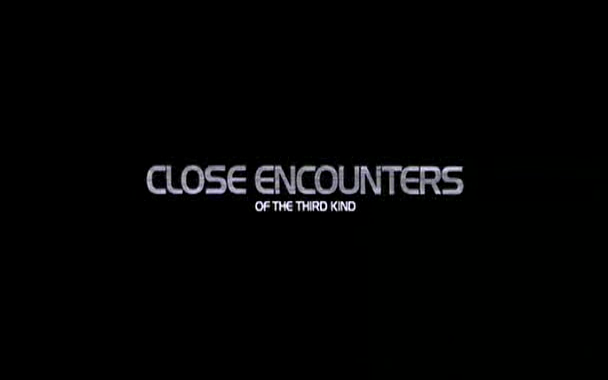
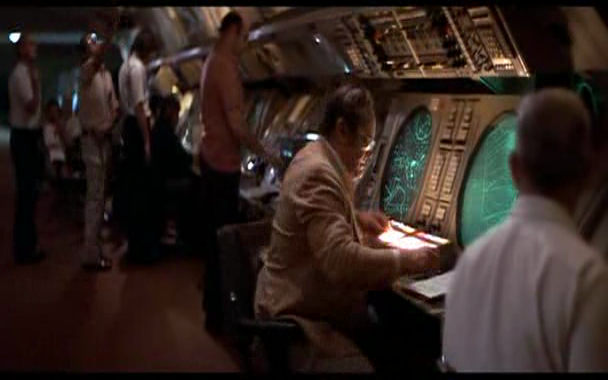
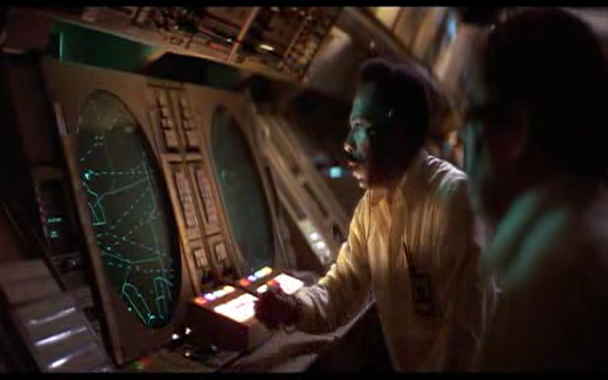
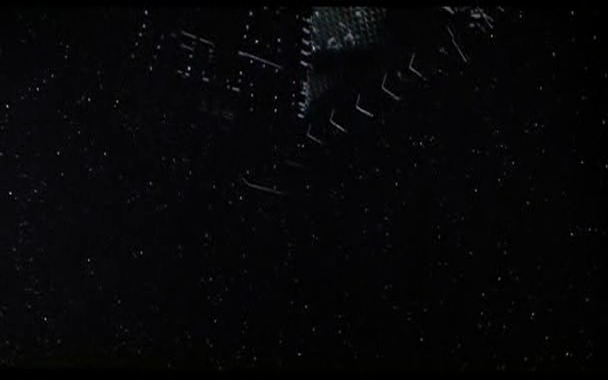
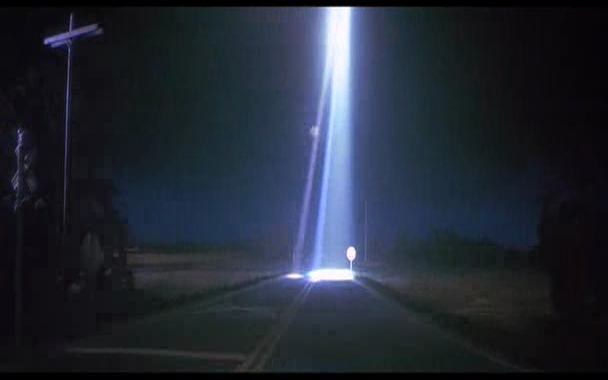


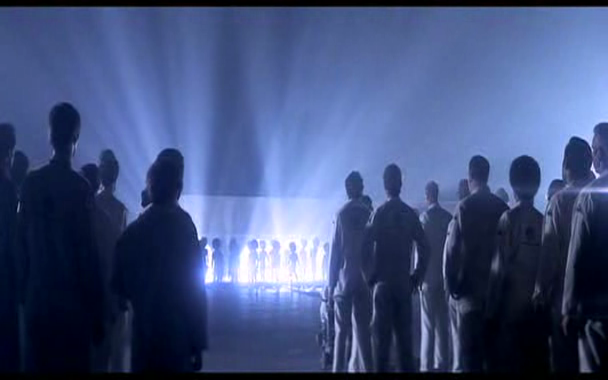

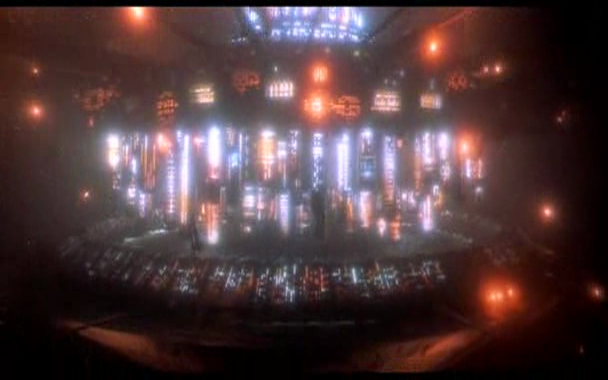
Close Encounters Of The Third Kind (1977)
Film review #7
dir. Steven Spielberg
1977’s “other” sci-fi movie is the film of choice this week. The title of “other” is solely due to 1977 being the year that a little sci-fi movie called Star Wars was also released…
As in Contact, the film deals with the possibilities of first contact with extraterrestrials. In parallel to this, it also deals with the impact on the lives of people caught in the middle, having received a message from the aliens.
Imagining contact with aliens is imagined in many different ways, and in Close Encounters… it is probably the highlight of the film. The use of sound and light is quite spectacular, using bright beams of colour-coded light, and playing musical notes to communicate is something that would be a real possibility in the future should we ever have to communicate with aliens. The idea of mathematics being the only “universal language” is something that should be remembered. Combined with the use of sound, it really accentuates the relationship between music and mathematics.
The inclusion of a church/prayer scene just before the volunteers go aboard the UFO is of significance. Again, like Contact, religion and science mixing seems like a dangerous and messy thing to do, but if one is going to choose people to represent humanity to extraterrestrials, shouldn’t they represent the ~90% of people on the planet who believe in a religion?
Being a big budget movie by Steven Spielberg, the special effects and locations are grand in scale and don’t disappoint. The music being composed by John Williams as well is interesting, seeing as he composed the music for Star Wars the very same year. Two different science-fiction films produced two different soundtracks.
The main difference between Close Encounters… and films like Contact is the fact that Close Encounters… actually shows the aliens in the flesh. Rather controversial, since there is no way to imagine what aliens will look like…but the film is not a scientific simulation, it is a drama and a mystery, and perhaps having a resolution helps complete the story in a more traditional sense. The aliens are only seen with light shining from behind them, and subsequently darkening the features of the alien. It is important to note the short, skinny and silver figure of the alien is seemingly based on the various U.F.O. sightings and close encounters people have reported over the years, so it builds on the real-life accounts and takes them one step further.
There are still many questions at the end with regards to the aliens, how they got to Earth, what they are like etc. since the mothership only appears during the last 10 or so minutes. But since this a first contact situation, merely establishing a means of communication would be extensively difficult, and it would take a long time before meaningful dialogue would take place between two species. I think a line in the film sums it up perfectly:
“It’s like the first day of school…”
-
#5 – Dr. Strangelove (or: How I Learned to Stop Worrying and Love the Bomb)
-
#4 – Metropolis (1927)
Metropolis (1927)
Film review #4
Dir. Fritz Lang
Widely regarded as the one of the most important science-fiction films, and most certainly one of the first. Metropolis is A silent German expressionist movie that tells the story of a dystopia that has a deep divide between the working class of the so-called “undercity”, and the upper class who live above ground. The sets and design of the city seems to be influenced by the artists movements of the time, such as modernism and futurism (This is true especially in terms of the cars). When this film was released in 1927, it should be noted that the world’s population had no real concept of technology and architecture on the scale that this film shows, so seeing it back then must have been a truly unique experience.
The film also delves into some religious iconography too. With numerous scenes taking place in abandoned cathedrals and catacombs, long since abandoned as obviously technology has overcome the idea of a God, and secured man’s triumphant victory over the notion of any deity. The ideas of the “mediator of the hand and head being the heart” is an interesting concept that is explored too., and perhaps serves as a warning about how much power we as a species should submit to technology, as it might not be worth the cost to our humanity…
The plot generally centres around the privileged son of the leader of “Metropolis”, and as we see him travel around the city, we see the differences in the classes is very apparent, and the upper and lower classes seem to lead completely different lives. For example, the Lower classes never see the sky as they live so far underground. The upper classes themselves are not taught about the lower classes, and their existence is barely acknowledged. But perhaps the most interesting difference to me is the concept that the working class do ten hour shifts and the clocks in the undercity only going up to ten was something I found pretty interesting: Different classes having different time structures…very intriguing. Perhaps you might think that the issue of class and division is something that has been addressed in cinema so many times it is nothing special, but you have to remember that Metropolis was one of the first films to address such concerns.
Metropolis was also one of the first films to utilise the concept of a human-like robot. This machine can copy a humans features exactly, and plays a key part in the plot of the movie. Just another example if the blurring of the boundaries between humans and technology.
If you think some of those images seem familiar, you may be right. The music video for Queen’s “Radio Ga Ga” uses footage from the film, and the singer Madonna’s song “Express Yourself” is written about this movie too.
So overall, I would highly recommend watching Metropolis if you have any interest in the history of science-fiction or cinema in general. It has a lot of firsts for cinema, and sets the benchmark for science-fiction story telling. Perhaps a two-and-a-half hour silent film is not everyone’s idea of a good movie, but what it accomplished at the time of release set itself apart from everything else, and no doubt has influenced cinema and science-fiction to this very day.

